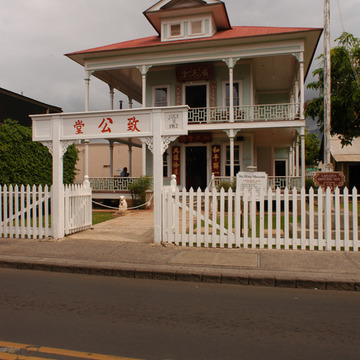An excellent example of a turn-of-the-twentieth-century Chinese Tong house, this imposing two-story, single-wall building is characterized by its wraparound lanai on the first and second stories and its hipped roof with prominent gabled dormers. Red and gold Chinese panels flank both first- and second-story doorways, and an Asian-style balustrade adorns the lanai. Separated from the commercial clamor of the street by a picket fence with an entrance proclaiming the name of the society's parent organization, Chee Kung Tong, the society hall is open to the public as a museum operated by the Lahaina Restoration Foundation. As in most Chinese fraternal halls, the first floor served as a social and recreational space which welcomed guests, women, and children. The second floor was reserved for members and accommodated religious functions, and usually included an altar for Kwan Dai (Ti), the god of compassion and justice.
Hawaii's Chinese Tong societies are fraternal clubs whose roots may be traced back to seventeenth-century China's secret Hoong Moon Society. Formed in reaction to the foreign invasion of China and later the rule of the Manchu, these organizations worked for political ends, for instance, the reestablishment of the Ming dynasty. The thirty or so Chinese societies founded in Hawaii between 1869 and 1910, however, were not significantly interested in the political aspects of their parent organizations, serving primarily as mutual aid societies addressing the social and recreational needs of their members. They also provided services now covered by insurance companies, offering care in times of illness, funeral services, and burial. In addition to providing financial assistance and fellowship to their members, the fraternal societies served as cultural centers for the Chinese in Hawaii. Many of these societies also provided the necessary monetary support for Dr. Sun Yat-Sen's successful 1911 revolution in China.
The name of the Wo Hing Society means “the restoration of harmony.” The society was incorporated in 1905, remained active in Lahaina until the 1940s, and then declined as the membership dwindled. In 1983 the Lahaina Restoration Foundation entered into a long-term agreement with the society and restored this building and its adjoining cookhouse.















